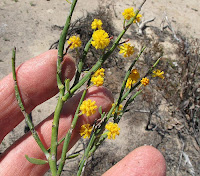Click image to enlarge
Acacia deficiens – Fabaceae
The botanical name of Acacia deficiens refers to the lack of phyllodes [leaf stalks (petioles) modified to look and behave like a leaf], which are restricted to near the base of the plant. The branches are rounded or slightly angled in cross-section and end in a sharp point. These features probably help the plant through the hot dry summers of the inland mallee where it naturally occurs.
Acacia deficiens is common to the mallee where sandy loams often overlie limestone. Going on surrounding mature vegetation not burnt for many years, odd plants of this species can sometimes be found that look ancient by having a centre completely devoid of new growth and green vegetation. In areas recently burnt, the colonies are much larger (although not congested) with plants resprouting from their rootstock along with freshly germinated individuals.
The long unarmed branches that are only sharp at their summit, make this species quite distinctive in the region bounded by the triangular area of Moora, Wagin and Mt. Ragged. I know it from the NE, North and NW of Esperance, where locally in can be quite common. It is usually little more than half a metre (18”) in height, but can spread to around 1.5 metres (5’) in diameter. The bright golden yellow flowers can be seen between September and November.







